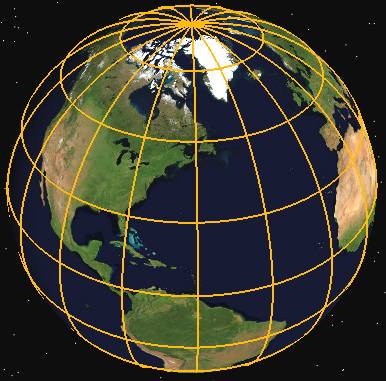|
MEGAPTERA
NOVAEANGLIAE
Length: 13–17 meters
Weight: 25–40 tons.
Worldwide population: 10.000–15.000 individuals
Life expectancy: Ca. 95 years
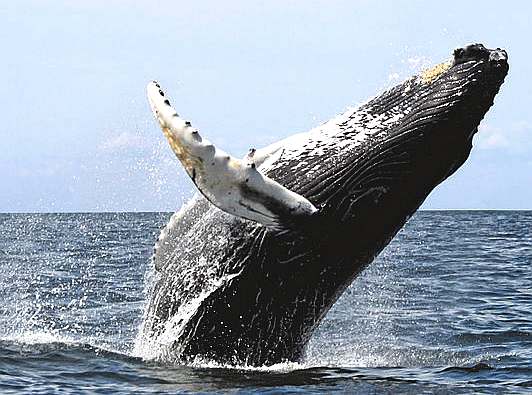
The
Humpback Whale famous for broaching
The
hump back whale in Icelandic waters is 12,5-13 m long.
The females weigh 30-48 tons and the males 25-35.
Its life expectancy is about 95 years.
The flippers are very long, usually black, or black and
white on top with a white underside, and their front edge is
knobby. The back is
black and the underside is light coloured.
The colour pattern on the neck and the breast are
variable. The
baleens are dark grey. The
white and black patterns on the underside of the flukes are used
as fingerprints to recognize the individuals.
The humpback whale occurs in all of the world’s oceans.
In the North Atlantic, the whales’ habitat reaches
between Northwest Africa and the West Indies to the ice edge in
the northern seas. Mating
takes place during the migration in March-May, the gestation
period is 11 months and pregnancy occurs every two years.
The calf is 4½-5 m long at birth and is suckled for 5
months.
The mainstay of the food is krill, but also small fishes, such
as capelin and herring. Humpbacks
are often found in shoals of 2-20 animals and are rather slow
swimmers. Their
curiosity often draws them to passing vessels and sometimes they
leap high out of the water.
Each dive takes 15-20 minutes and sometimes a few animals
round scattered schools of small fishes up by releasing air from
below them and then ascend gaping to fill their mouths.
They communicate or “sing” much during the mating
period and are observed closed to shore than other large
species.
Humpbacks were a rare species off the Icelandic coast after the
overexploitation of the Norwegians and have been totally
protected since 1955. Their
main summer habitats were off the east- and southeast coast, but
they were caught all around the country.
Parts of the stocks remain in the northern seas during
winter as well. Pregnant
cows swim south to give birth and then return in summer.
American harpoons have been found in humpbacks off the
North Norwegian coast.
Humpbacks are among the most spotted species during whale
watching tours all around the country.
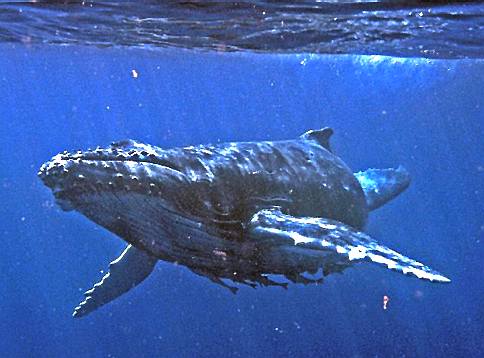
A
Humpback Whale with fish attached
The humpback whale
(Megaptera novaeangliae) is a species of baleen whale. One of the larger rorqual species, adults range in length from 12–16 metres (39–52 ft) and weigh approximately 36,000 kilograms (79,000 lb). The humpback has a distinctive body shape, with unusually long pectoral fins and a knobbly head. It is an acrobatic animal, often breaching and slapping the water. Males produce a complex song, which lasts for 10 to 20 minutes and is repeated for hours at a time. The purpose of the song is not yet clear, although it appears to have a role in mating.
Found in oceans and seas around the world, humpback whales typically migrate up to 25,000 kilometres (16,000 mi) each year. Humpbacks feed only in summer, in polar waters, and migrate to tropical or sub-tropical waters to breed and give birth in the winter. During the winter, humpbacks fast and live off their fat reserves. The species' diet consists mostly of krill and small fish. Humpbacks have a diverse repertoire of feeding methods, including the bubble net feeding technique.
Like other large whales, the humpback was and is a target for the whaling industry. Due to over-hunting, its population fell by an estimated 90% before a whaling moratorium was introduced in 1966. Stocks have since partially recovered; however, entanglement in
fishing gear, collisions with ships, and noise pollution also remain concerns. There are at least 80,000 humpback whales worldwide. Once hunted to the brink of extinction, humpbacks are now sought by whale-watchers, particularly off parts of
Australia, New
Zealand, South
America, Canada, and the United States.
|
|
|
|
|
|
B.
physalus (fin
whale)
|
|
|
|
B.
edeni (pygmy
Bryde's whale)
|
|
|
|
B.
borealis
(Sei
whale)
|
|
|
B.
brydei
(Bryde's
whale)
|
|
|
|
|
|
|
|
|
|
B.
musculus (blue
whale)
|
|
|
Megaptera
novaeangliae
(humpback whale)
|
|
|
Eschrichtius
robustus (gray
whale)
|
|
|
|
|
|
|
|
|
A phylogenetic tree of animals related to the humpback whale
Taxonomy
Humpback whales are rorquals (family
Balaenopteridae), a family that includes the blue whale, the fin whale, the Bryde's whale, the sei whale and the minke whale. The rorquals are believed to have diverged from the other families of the suborder Mysticeti as long ago as the middle
Miocene. However, it is not known when the members of these families diverged from each other.
Though clearly related to the giant whales of the genus
Balaenoptera, the humpback has been the sole member of its genus since Gray's work in 1846. More recently though, DNA sequencing analysis has indicated the Humpback is more closely related to certain
rorquals, particularly the fin whale (Balaenoptera physalus), and possibly to the gray whale
(Eschrichtius robustus), than it is to rorquals such as the minke
whales. If further research confirms these relationships, it will be necessary to reclassify the
rorquals.
The humpback whale was first identified as "baleine de la Nouvelle
Angleterre" by Mathurin Jacques Brisson in his Regnum Animale of 1756. In 1781, Georg Heinrich Borowski described the species, converting Brisson's name to its Latin equivalent, Balaena
novaeangliae. In 1804, Lacépède shifted the humpback from the Balaenidae family, renaming it Balaenoptera
jubartes. In 1846, John Edward Gray created the genus Megaptera, classifying the humpback as Megaptera
longipinna, but in 1932, Remington Kellogg reverted the species names to use Borowski's
novaeangliae. The common name is derived from the curving of their back when diving. The generic name Megaptera from the Greek mega-/μεγα- "giant" and
ptera/πτερα
"wing", refers to their large front flippers. The specific name means "New Englander" and was probably given by Brisson due the regular sightings of humpbacks off the coast of New
England.
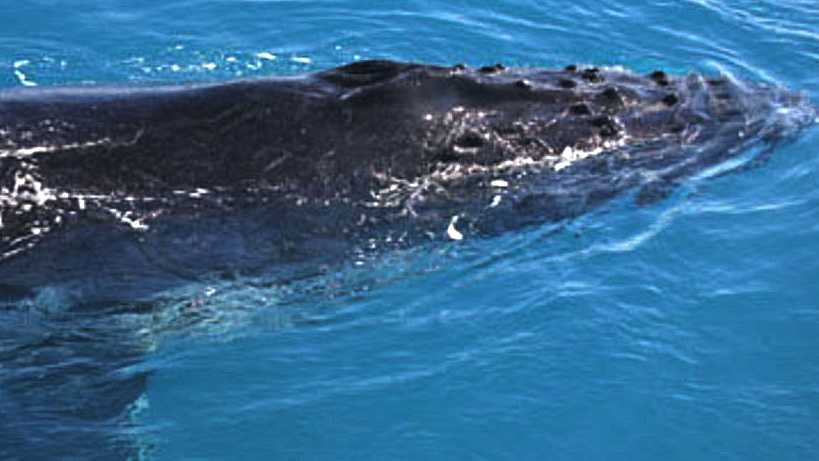
The
head of a young humpback whale
Description
A humpback whale can easily be identified by its stocky body with an obvious hump and black dorsal coloring. The head and lower jaw are covered with knobs called tubercles, which are actually hair follicles, and are characteristic of the species. The fluked tail, which it lifts above the surface in some dive sequences, has wavy trailing
edges. The four global populations, all under study, are: North Pacific, Atlantic, and Southern Ocean humpbacks, which have distinct populations which complete a migratory round-trip each year and the
Indian Ocean population, which does not migrate, prevented by that ocean's northern coastline.
The long black and white tail fin, which can be up to a third of body length, and the pectoral fins have unique patterns, which make individual whales
identifiable. Several hypotheses attempt to explain the humpback's pectoral fins, which are proportionally the longest fins of any cetacean. The two most enduring mention the higher maneuverability afforded by long fins, and the usefulness of the increased surface area for temperature control when migrating between warm and cold climates. Humpbacks also have
'rete mirabile', a heat exchanging system, which works similarly in humpbacks, sharks and other
fish.
A tail from a different individual - the tail of each humpback whale is visibly unique.Humpbacks have 270 to 400 darkly coloured baleen plates on each side of the mouth. The plates measure from a mere 18 inches (46 cm) in the front to approximately 3 feet (0.91 m) long in the back, behind the hinge. Ventral grooves run from the lower jaw to the umbilicus about halfway along the underside of the whale. These grooves are less numerous (usually 16–20) and consequently more prominent than in other
rorquals.
The stubby dorsal fin is visible soon after the blow when the whale surfaces, but disappears by the time the flukes emerge. Humpbacks have a 3 metres (9.8 ft) heart-shaped to bushy blow, or exhalation of water through the blowholes. Because Humpback Whales breathe voluntarily, it is possible that the whales shut off only half of the brain when
sleeping. Early whalers also noted blows from humpback adults to be 10–20 feet (3.0–6.1 m) high.
Newborn calves are roughly the length of their mother's head. At birth, calves measure 20 feet (6.1 m) at 2 short tons (1.8 t) The mother, by comparison, is about 50 feet (15 m). They nurse for approximately six months, then mix nursing and independent feeding for possibly six months more. Humpback milk is 50% fat and pink in color. Some calves have been observed alone after arrival in
Alaskan
waters.
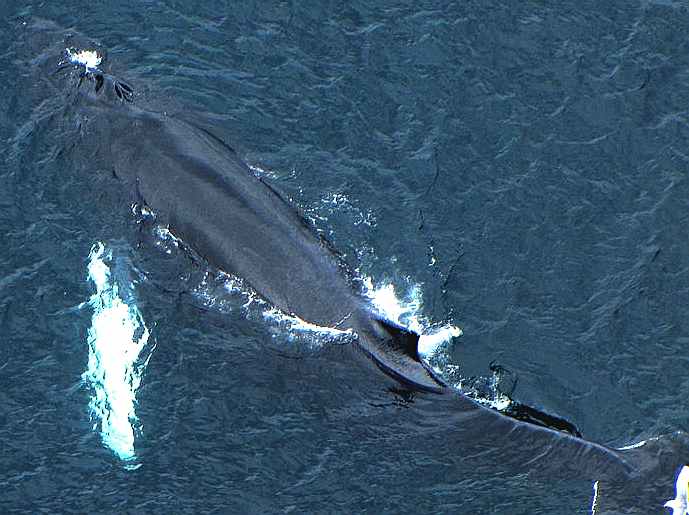
Young
humpback whale with blowholes clearly visible
Females reach sexual maturity at the age of five, achieving full adult size a little later. Males reach sexual maturity at approximately 7 years of age. The humpback whale lifespan ranges from 45–100
years.
Fully grown, the males average 15–16 metres (49–52 ft). Females are slightly larger at 16–17 metres (52–56 ft), and 40,000 kilograms (44 short tons); the largest recorded specimen was 19 metres (62 ft) long and had pectoral fins measuring 6 metres (20 ft)
each.
Females have a hemispherical lobe about 15 centimetres (5.9 in) in diameter in their genital region. This visually distinguishes males and females. The male's penis usually remains hidden in the genital slit. Male whales have distinctive scars on heads and bodies, some resulting from battles over
females.
Identifying individuals
The varying patterns on the tail flukes are sufficient to identify individuals. Unique visual identification is not currently possible in most cetacean species (other exceptions include orcas and right whales), making the humpback a popular study
species. A study using data from 1973 to 1998 on whales in the North Atlantic gave researchers detailed information on gestation times, growth rates, and calving periods, as well as allowing more accurate population predictions by simulating the mark-release-recapture technique (Katona and Beard 1982). A photographic catalogue of all known North Atlantic whales was developed over this period and is currently maintained by College of the
Atlantic. Similar photographic identification projects have begun in the North Pacific by SPLASH (Structure of Populations, Levels of Abundance and Status of Humpbacks), and around the world.
Reproduction
Females typically breed every two or three years. The gestation period is 11.5 months, yet some individuals have been known to breed in two consecutive years. The peak months for birth are January, February, July, and August. There is usually a 1-2 year period between humpback births. Humpback whales can live up to 48 years.
Recent research on humpback mitochondrial DNA reveals that groups that live in proximity to each other may represent distinct breeding
pools.
A humpback in the waters of the Abrolhos Archipelago
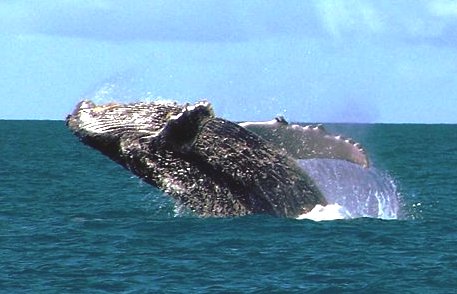
A humpback whale
broaching backwards
Social structure
Whale surfacing behaviour
Humpbacks frequently breach, throwing two thirds or more of their bodies out of the water and splashing down on their backs.
The humpback social structure is loose-knit. Typically, individuals live alone or in small, transient groups that disband after a few hours. These whales are not excessively social in most cases. Groups may stay together a little longer in summer to forage and feed cooperatively. Longer-term relationships between pairs or small groups, lasting months or even years, have rarely been observed. It is possible that some females retain bonds created via cooperative feeding for a lifetime. The humpback's range overlaps considerably with other whale and dolphin species — for instance, the minke whale. However, humpbacks rarely interact socially with them, though humpback calves in
Hawaiian waters sometimes play with bottlenose
dolphin
calves.
Courtship
Courtship rituals take place during the winter months, following migration toward the equator from summer feeding grounds closer to the poles. Competition is usually fierce, and unrelated males dubbed escorts by researcher Louis Herman frequently trail females as well as mother-calf dyads. Groups of two to twenty males gather around a single female and exhibit a variety of behaviors over several hours to establish dominance of what is known as a competitive group. Group size ebbs and flows as unsuccessful males retreat and others arrive to try their luck. Behaviors include breaching, spyhopping, lob-tailing, tail-slapping, fin-slapping, peduncle throws, charging and parrying. Less common "super pods" may number more than 40 males, all vying for the same female. (M. Ferrari et al.)
Whale song is assumed to have an important role in mate selection; however, scientists remain unsure whether song is used between males to establish identity and dominance, between a male and a female as a mating call, or
both.
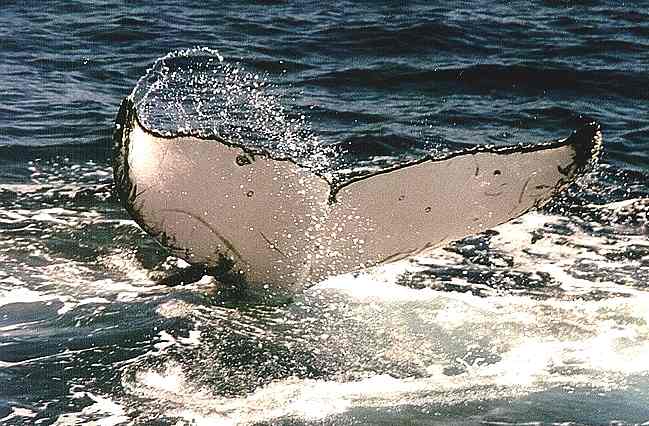
A humpback whale tail displaying wavy rear edges
Whale song
Spectrogram of Humpback Whale vocalizations. Detail is shown for the first 24 seconds of the 37-second recording "Singing Humpbacks". The ethereal whale "songs" and echolocation "clicks" are visible as horizontal striations and vertical sweeps respectively. Spectrogram generated with Fatpigdog's PC based Real Time FFT Spectrum Analyzer. Singing Humpbacks
Both male and female humpback whales vocalize, however only males produce the long, loud, complex "songs" for which the species is famous. Each song consists of several sounds in a low register that vary in amplitude and frequency, and typically lasts from 10 to 20
minutes. Humpbacks may sing continuously for more than 24 hours. Cetaceans have no vocal cords, so whales generate their song by forcing air through their massive nasal cavities.
Whales within a large area sing the same song. All North Atlantic humpbacks sing the same song, and those of the North Pacific sing a different song. Each population's song changes slowly over a period of years without
repeating.
Scientists are unsure of the purpose of whale song. Only males sing, suggesting that one purpose is to attract females. However, many of the whales observed to approach a singer are other males, and results in conflict. Singing may therefore be a challenge to other
males. Some scientists have hypothesized that the song may serve an echolocative
function. During the feeding season, humpbacks make altogether different vocalizations for herding fish into their bubble
nets.
All these behaviors also occur absent potential mates. This indicates that they are probably a more general communication tool. Scientists hypothesize that singing may keep migrating populations connected. (Ferrari, Nicklin, Darling, et al.) Some observers report that singing begins when competition for a female
ends.
Humpback whales have also been found to make a range of other social sounds to communicate such as "grunts", "groans", "thwops", "snorts" and
"barks".
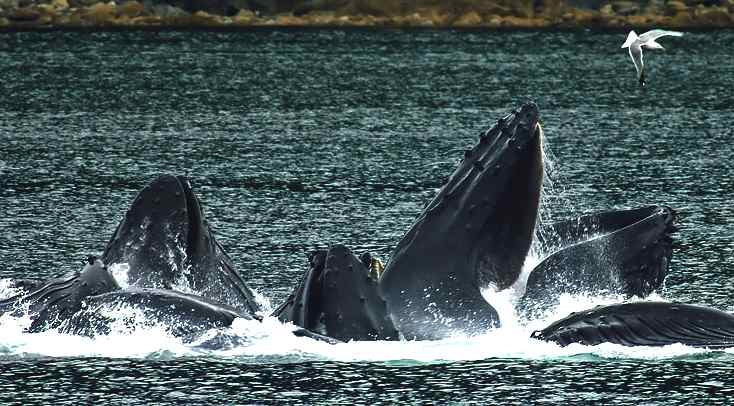
A group of 15 whales bubble net fishing near Juneau, Alaska
Ecology
Feeding
Humpbacks feed primarily in summer and live off fat reserves during
winter. They feed only rarely and opportunistically in their wintering waters. The humpback is an energetic hunter, taking krill and small schooling fish such as Atlantic herring, Atlantic
salmon, capelin, and American sand lance as well as Atlantic mackerel, pollock, and haddock in the North
Atlantic. Krill and copepods have been recorded as prey species in Australian and Antarctic
waters. Humpbacks hunt by direct attack or by stunning prey by hitting the water with pectoral fins or flukes.
The humpback has the most diverse feeding repertoire of all baleen
whales. Its most inventive technique is known as bubble net feeding: a group of whales swims in a shrinking circle blowing bubbles below a school of prey. The shrinking ring of bubbles encircles the school and confines it in an ever-smaller cylinder. This ring can begin at up to 30 metres (98 ft) in diameter and involve the cooperation of a dozen animals. Using a crittercam attached to a whale's back it was discovered that some whales blow the bubbles, some dive deeper to drive fish toward the surface, and others herd prey into the net by
vocalizing. The whales then suddenly swim upward through the 'net', mouths agape, swallowing thousands of fish in one gulp. Plated grooves in the whale's mouth allow the creature to easily drain all the water that was initially taken in.
Predation
Given scarring records, killer whales are thought to prey upon juvenile humpbacks, though this has never been witnessed. The result of these attacks is generally nothing more serious than some scarring of the skin, but it is likely that young calves are sometimes
killed.
Range and habitat
Humpbacks inhabit all major oceans, in a wide band running from the Antarctic ice edge to 77° N latitude, though not in the eastern Mediterranean or the Baltic Sea.
Humpbacks are migratory, spending summers in cooler, high-latitude waters and mating and calving in tropical and subtropical
waters. An exception to this rule is a population in the Arabian Sea, which remains in these tropical waters
year-round. Annual migrations of up to 25,000 kilometres (16,000 mi) are typical, making it one of the mammal's best-traveled species.
A large population spreads across the Hawaiian islands every winter, ranging from the island of Hawaii in the south to Kure Atoll in the
north. A 2007 study identified seven individuals wintering off the Pacific coast of Costa Rica as having traveled from the
Antarctic — around 8,300 kilometres (5,200 mi). Identified by their unique tail patterns, these animals made the longest documented mammalian
migration.
In Australia, two main migratory populations have been identified, off the west and east coast respectively. These two populations are distinct, with only a few females in each generation crossing between the two
groups.
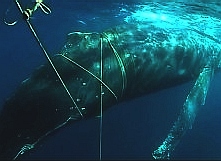
Entangled
in rope, a humpback struggles
Whaling in Japan
Humpback whales were hunted as early as the 18th century, but distinguished by whalers as early as the first decades of the 17th century.
By the 19th century, many nations (the United States in particular), were hunting the animal heavily in the Atlantic Ocean, and to a lesser extent in the Indian and Pacific Oceans. It was, however, the late 19th century introduction of the explosive harpoon that allowed whalers to accelerate their take. This, along with hunting in the Antarctic Ocean beginning in 1904, sharply reduced whale populations.
It is estimated that during the 20th century, at least 200,000 humpbacks were taken, reducing the global population by over 90%, with North Atlantic populations estimated to have dropped to as low as 700
individuals. In 1946, the International Whaling Commission was founded to oversee the whaling industry. They imposed rules and regulations for hunting whales and set open and closed hunting seasons. To prevent extinction, the International Whaling Commission banned commercial humpback whaling in 1966. By that time the population had been reduced to around
5,000. That ban is still in force.
Prior to commercial whaling, populations could have reached 125,000. North Pacific kills alone are estimated at
28,000. The full toll is much higher. It is now known that the Soviet Union was deliberately under-recording its catches; the
Soviet catch was reported at 2,820 whereas the true number is now believed to be over
48,000.
As of 2004, hunting of humpback whales was restricted to a few animals each year off the Caribbean island Bequia in the nation of St. Vincent and the
Grenadines. The take is not believed to threaten the local population.
Japan had planned to kill 50 humpbacks in the 2007/08 season under its JARPA II research program, starting in November 2007. The announcement sparked global
protests. After a visit to Tokyo by the chairman of the IWC, asking the Japanese for their co-operation in sorting out the differences between pro- and anti-whaling nations on the Commission, the Japanese whaling fleet agreed that no humpback whales would be caught for the two years it would take for the IWC to reach a formal
agreement.
In 2010 the International Whaling Commission authorized Greenland’s native population to hunt a few humpback whales for the next three
years.
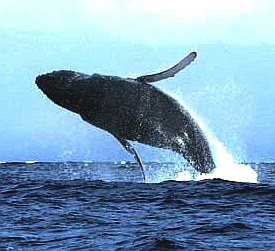
A humpback whale
broaching sideways
Conservation
There are at least 80,000 humpback whales worldwide, with 18,000-20,000 in the North
Pacific, about 12,000 in the North Atlantic, and over 50,000 in the Southern
Hemisphere, down from a pre-whaling population of 125,000.
This species is considered "least concern" from a conservation standpoint, as of 2008. This is an improvement from vulnerable in the prior assessment. Most monitored stocks of humpback whales have rebounded well since the end of commercial
whaling, such as the North Atlantic where stocks are now believed to be approaching pre-hunting levels. However, the species is considered endangered in some countries, including the United
States. The United States initiated a status review of the species on August 12, 2009, and is seeking public comment on potential changes to the species listing under the U.S. Endangered Species
Act. Areas where population data is limited and the species may be at higher risk include the Arabian Sea, the western North Pacific Ocean, the west coast of Africa and parts of
Oceania.
Today, individuals are vulnerable to collisions with ships, entanglement in fishing gear, and noise
pollution. Like other cetaceans, humpbacks can be injured by excessive noise. In the 19th century, two humpback whales were found dead near sites of repeated oceanic sub-bottom blasting, with traumatic injuries and fractures in the
ears.
Once hunted to the brink of extinction, the humpback has made a dramatic comeback in the North Pacific. A 2008 study estimates that the humpback population that hit a low of 1,500 whales before hunting was banned worldwide, has made a comeback to a population of between 18,000 and
20,000.
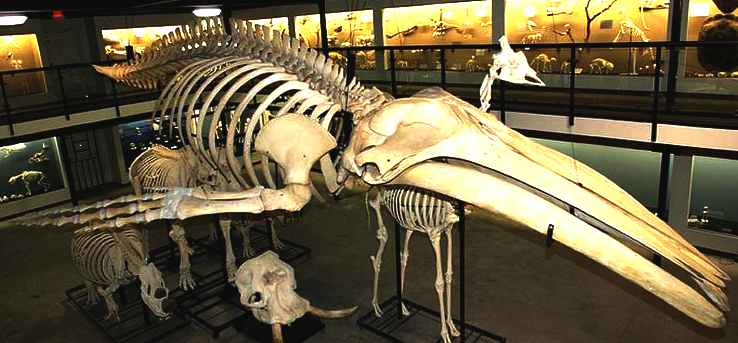
Humpback Whale Skeleton on Display at The Museum of Osteology, Oklahoma City, Oklahoma
Saxitoxin, a paralytic shellfish poisoning (PSP) from contaminated mackerel has been implicated in humpback whale
deaths.
The United
Kingdom, among other countries, designated the humpback as a priority species under the national Biodiversity Action Plan.
The sanctuary provided by U.S. National Parks such as Glacier Bay National Park and Preserve and Cape Hatteras National Seashore, among others, have also become major factors in sustaining
populations.
Although much was learned about humpbacks from whaling, migratory patterns and social interactions were not well understood until two studies by R. Chittleborough and W. H. Dawbin in the
1960s. Roger Payne and Scott McVay made further studies of the species in
1971. Their analysis of whale song led to worldwide media interest and convinced the public mind that whales were highly intelligent, aiding the anti-whaling advocates.
In August 2008, the IUCN changed humpback's status from Vulnerable to Least Concern, although two subpopulations remain
endangered.
The United States is considering listing separate humpback populations, so that smaller groups, such as North Pacific humpbacks, which are estimated to number 18,000-20,000 animals, might be
de-listed. This is made difficult by humpback's extraordinary migrations, which can extend the 5,157 miles (8,299 km) from Antarctica to Costa
Rica.
Whale watching
Humpback whales are generally curious about objects in their environment. Some individuals, referred to as "friendlies", approach whale-watching boats closely, often staying under or near the boat for many minutes. Because humpbacks are often easily approachable, curious, easily identifiable as individuals, and display many behaviors, they have become the mainstay of whale-watching tourism in many locations around the world. Hawaii has used the concept of "eco tourism" to use the species without killing them. This whale watching business attracts 1 million visitors a year, which results in a profit of
$80
million.
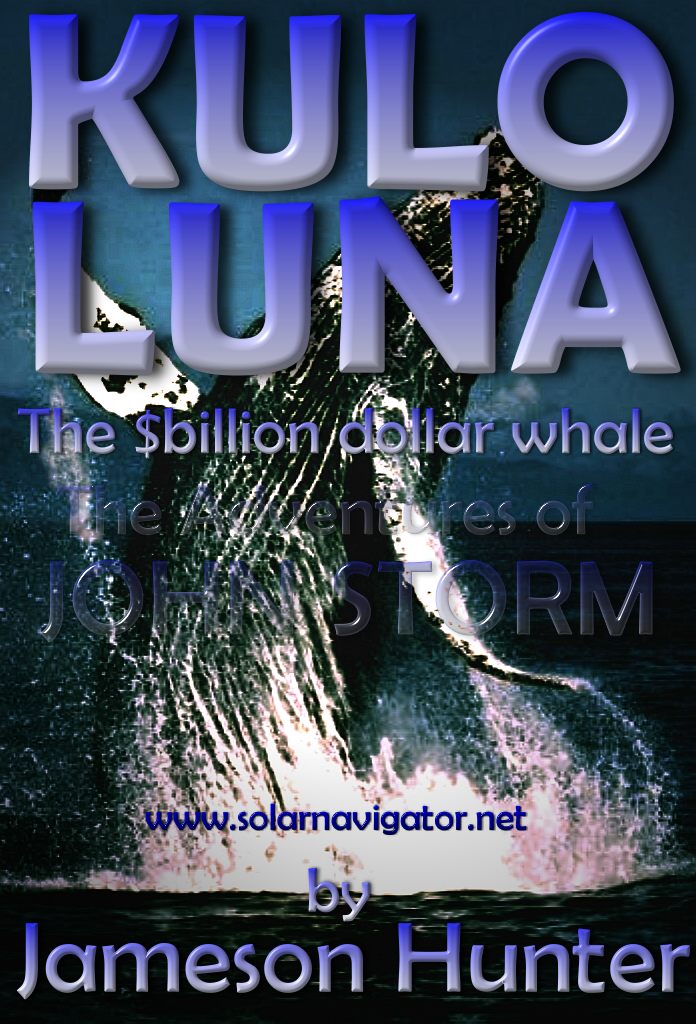
Kulo
Luna is a modern Moby Dick with an environmental twist
The
film production company Blueplanet Netdirect are developing
a
script from this book by Jameson Hunter
There are many commercial whale-watching operations on both the humpback's summer and winter
ranges:
North Atlantic North Pacific Southern Hemisphere
Summer
New England, Nova Scotia and Newfoundland, the northern St. Lawrence River, the Snaefellsnes peninsula in the west of Iceland California,
Alaska, Oregon, Washington, British Columbia Antarctica, Bahía Solano and Nuquí in
Colombia
Winter
Samaná Province of the Dominican Republic, the Bay of Biscay France, Hawaii, Baja, the Bahía de Banderas off Puerto Vallarta Sydney, Byron Bay north of Sydney, Hervey Bay north of Brisbane, North and East of Cape Town,
New Zealand, the Tongan islands,
As with other cetacean species, however, a mother whale is generally extremely protective of her infant, and places herself between any boat and her calf before moving quickly away from the vessel. Skilled tour operators avoid stressing the
mother.
The
Aleutian Islands - Humpback feeding ground
Famous
humpbacks
Migaloo
A presumably albino humpback whale that travels up and down the east coast of Australia has become famous in the local media, on account of its extremely rare all-white appearance. Migaloo is the only known all-white humpback whale in the
world. First sighted in 1991 and believed to be 3–5 years old at that time, Migaloo is a word for "white
fella" from one of the languages of the Aboriginals, the Indigenous Australians. Speculation about Migaloo's sex was resolved in October 2004 when researchers from Southern Cross University collected sloughed skin samples from Migaloo as he migrated past Lennox Head, and subsequent genetic analysis of the samples proved he is a male. Because of the intense interest, environmentalists feared that he was becoming distressed by the number of boats following him each day. In response, the Queensland and New South Wales governments introduce legislation each year to create a 500 m (1600 ft) exclusion zone around the whale. Recent close up pictures have shown Migaloo to have skin cancer and/or skin cysts as a result of his lack of protection from the
sun.
In 2006, a white calf was spotted with a normal humpback mother in Byron Bay, New South
Wales.
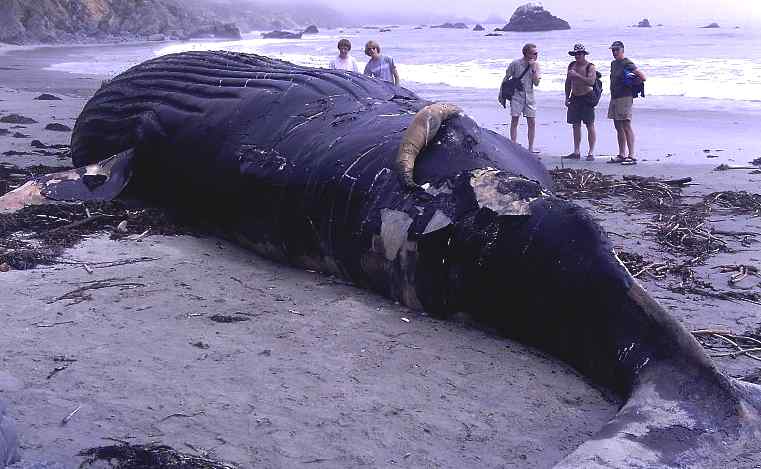
A
dead beached humpback whale, California
Humphrey the Whale
One of the most notable humpback whales is Humphrey the Whale, twice-rescued by The Marine Mammal Center and other concerned groups in
California. In 1985, Humphrey swam into San Francisco Bay and then up the Sacramento River towards Rio
Vista. Five years later, Humphrey returned and became stuck on a mudflat in San Francisco Bay immediately north of Sierra Point below the view of onlookers from the upper floors of the Dakin Building. He was pulled off the mudflat with a large cargo net and the help of the Coast Guard. Both times he was successfully guided back to the Pacific Ocean using a "sound net" in which people in a flotilla of boats made unpleasant noises behind the whale by banging on steel pipes, a Japanese fishing technique known as "oikami." At the same time, the attractive sounds of humpback whales preparing to feed were broadcast from a boat headed towards the open
ocean. Since leaving the San Francisco Bay in 1990 Humphrey has been seen only once, at the Farallon Islands in 1991.
HUMPBACK
FICTION - KULO LUNA
Like
Moby
Dick, Kulo Luna is a fictional animal in the book of the
same name. In Herman
Melvilles's book, the antagonist is a giant sperm whale of
the same name. In Jameson
Hunter's book, the antagonist is a Japanese whaling cartel.
In the days of Moby Dick, whaling was neither immoral nor
illegal. Times have changed. Having nearly wiped them out, the
vast majority of humans are
actively protecting whales.
Whereas
Moby Dick is set in the 1850s, Kulo Luna is set slightly in the
future. The human protagonist captains a robot
solar powered boat named SolarNavigator, seen at the foot of
this page. The boat is the subject of a real autonomous
research project for 2013. The story is not that far moved from
reality in that the Japanese still hunt whales and there are
many organisations trying to prevent them from killing these
fabulous animals.
LINKS:
Which
way now?
Environmentalists
hope to save the whales - again
-
Humpback
whale songs
-
Conservation

Japan
backs Iceland's whaling decision Seattle Post
Intelligencer - 18 Oct 2006
TOKYO -- Major pro-whaling nation Japan on
Wednesday welcomed Iceland's decision to resume
commercial whaling, saying Iceland's catch
won't "endanger the whale ...
Iceland
whaling decision condemned Stuff.co.nz
Greenpeace
'disappointed' by Iceland's whaling plans ABC
Online
Moves
begin on Iceland's whaling BBC News
Monsters
and Critics.com - Radio
New Zealand
Greens
dismayed at Iceland whaling decision
Scoop.co.nz (press release), New Zealand - 17
Oct 2006
News that Iceland is to begin commercial whaling
after a 20-year hiatus is being greeted with dismay by
Green Party Conservation Spokesperson Metiria Turei. ...
Iceland
to Resume Commercial Whaling
Los Angeles Times, CA - 17 Oct 2006
REYKJAVIK, Iceland -- Iceland said Tuesday
it would resume commercial whaling after a nearly
two-decade moratorium, defying a worldwide ban on
hunting the ...
Green
warrior to come to Iceland IcelandReview, Iceland -
20-10-06
... According to RÚV, the US government is also
opposed to Iceland resuming commercial whaling
and has the power to block all imports from Iceland
to USA. ...
Today's
Scoop Just Politics News Summary 17
Oct 2006
Scoop.co.nz (press release), New Zealand - commercial whaling administered by the
International Whaling Commission. See... Greens
dismayed at Iceland whaling decision
Update:
Finnair strike expected to continue next week
International Herald Tribune, France -
hours ago
... "We have received several e-mails from
people saying they have decided not to visit Iceland
as long as Iceland is conducting whaling,"
said Thorunn ...
Tharp She Gets Shot! The Return of Whaling in Iceland
19 Oct 2006
Plenty Magazine, NY -
which Iceland’s whales have been protected from hunters came to an end on Tuesday, when the country’s
lawmakers voted to resume commercial whaling in the ...
Whaling
is affecting tourism IcelandReview, Iceland -
19 Oct 2006
... of Swiss travel agency Baldinger Reisen AG sent a written statement to icelandreview.com yesterday,
expressing his concerns about Iceland resuming whaling.
...
Iceland,
Whales, Politics
FiNS Magazine, Singapore - 18 Oct 2006
... For a good overview on the Iceland
decision and the issues associated with commercial whaling
in general, see this recent article in the Guardian. ...
Iceland
to resume commercial whaling after almost 2
decades
USA Today 17-10-06
Critics say the "scientific" whaling
practiced by Japan and Iceland is a sham. Norway
ignores the moratorium altogether and openly conducts
commercial whaling.
Iceland's
Whaling Comeback
- Preparations for the Resumption of ...
The
Whale and Dolphin Conservation Society (WDCS) is the leading
international charity dedicated solely to the worldwide conservation and
welfare of all ... www.wdcs.org/dan/publishing.nsf/
allweb/B2460680BC28D8F480256D4A0040D97B
BBC
NEWS | Science/Nature | Moves begin on Iceland's whaling
Iceland's
ambassador to Britain is summoned to explain his country's return to
commercial whaling. news.bbc.co.uk/1/hi/sci/tech/6064028.stm
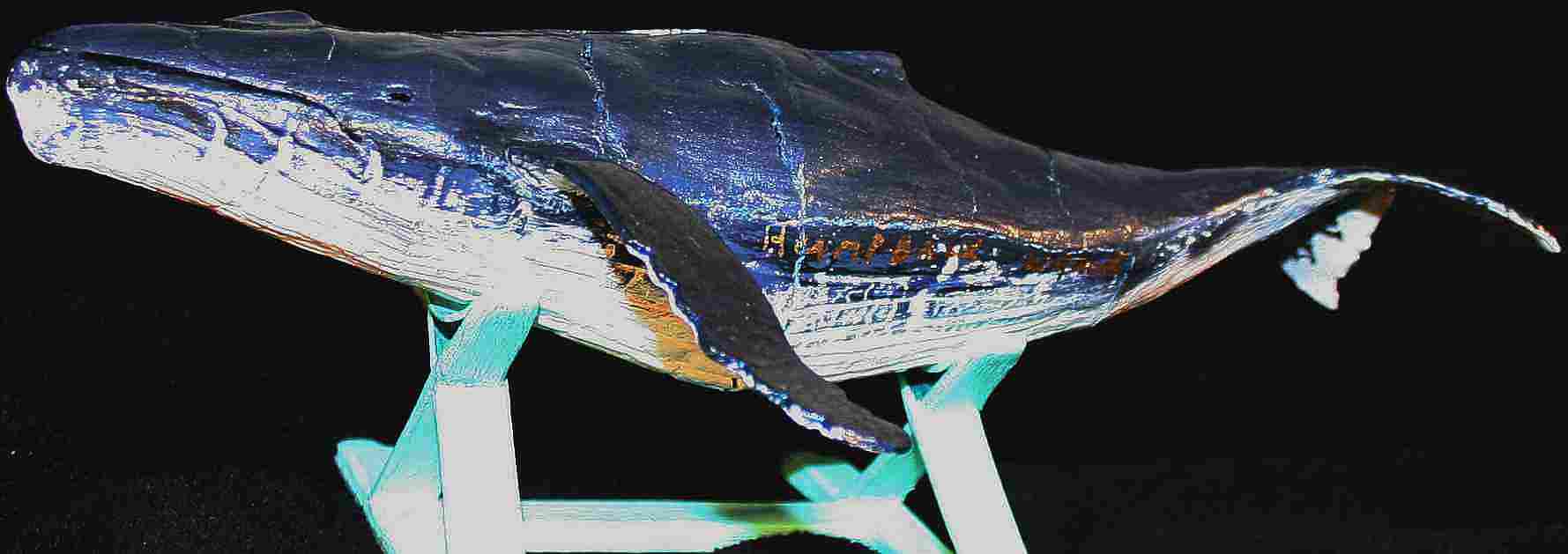
A
1/100th scale sculpture of a humpback whale made of white bread,
which,
unfortunately cracks a lot when drying out.
BBC
NEWS | Science/Nature | Iceland bids to resume whaling
Iceland
reveals its plans to catch whales again for the first time since 1989,
despite the international whaling moratorium. news.bbc.co.uk/1/hi/sci/tech/2910655.stm
Iceland
Whaling v/s Whale watching. Whaling v/s Whale
watching.
The
most commonly used argument in Iceland is that whaling must
be resumed before the whales start ... Yearly report on Iceland
whale watching industry: ... www.global500.org/news_83.html
Iceland
My
opinion: Iceland's reasons for scientific whaling are FUBAR
and if we can ... I wonder how many of you criticising Iceland's
whaling have actually read ... weblog.greenpeace.org/iceland/archives/001530.html
Stop
Icelandic whaling
Stop
Icelandic Whaling: Arctic Sunrise Expedition 2005, Stop Icelandic
Whaling: Arctic ... tourism in Iceland IF Iceland
discontinues whaling. One Icelandic ...
weblog.greenpeace.org/iceland/archives/2003_09.html
Greenpeace
'disappointed' by Iceland's whaling plans. 19/10/2006
Greenpeace
says it is very disappointed Iceland has decided to resume
commercial whaling Iceland has authorised an annual hunt of 30
minke and nine of the ...
www.abc.net.au/news/newsitems/200610/s1768443.htm
Earth
Island Institute
Iceland's
whaling proposal threatens its growing whale-watching industry.
In 2002, more than 62000 people went whale-watching in Iceland.
...
www.earthisland.org/takeaction/new_action.cfm?aaID=167
Japan
backs Iceland's whaling decision - Yahoo! News
Major
pro-whaling nation Japan on Wednesday welcomed Iceland's
decision to resume commercial whaling, saying Iceland's
catch won't "endanger the whale ...
news.yahoo.com/s/ap/20061019/
ap_on_re_eu/japan_iceland_whaling
Whales
on the Net - Iceland Whaling Protest Letter
I
am appalled to learn that Iceland has decided to resume commercial whaling
under the guise of scientific research, and plans to kill 38 minke whales
this ... www.whales.org.au/alert/iceletter.html
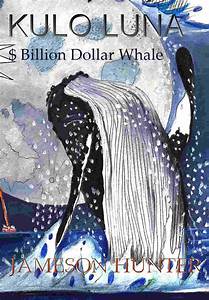
-
"Order
Cetacea (pp. 723-743)". In Wilson, Don E., and
Reeder, DeeAnn M., eds.
-
Mammal
Species of the World: A Taxonomic and Geographic Reference
(3rd ed.).
-
http://www.bucknell.edu/msw3/browse.asp?id=14300027.
-
Donovan,
G.P., Urbán, J. & Zerbini, A.N. (2008). Megaptera
novaeangliae.
-
"Whale
Evolution" (PDF). McGraw-Hill Yearbook of
Science & Technology. http://www-personal.umich.edu/~gingeric/PDFfiles/PDG413_Whaleevol.pdf.
-
"Cetacean
mitochondrial DNA control region". Molecular
Biology and lution http://mbe.oxfordjournals.org/cgi/content/abstract/10/5/960.
-
"Mitochondrial
Phylogenetics and Evolution of Mysticete Whales". Systematic
Biology 54 (1): 77–90. doi:10.1080/10635150590905939. 15805012.
-
Recovery
Plan for the Humpback Whale (Megapten Novaeangliae).
NOAA 1991.
http://www.nmfs.noaa.gov/pr/pdfs/recovery/whale_humpback.pdf.
-
"Resting
behavior in a rehabilitating gray whale calf" (pdf).
Aquatic Mammals 27.3: 256–266.
-
"Whalenet
Data Search". Wheelock College.
http://www.coa.e/alliedwhaleresearch.htm.
-
"Whale
Watch: Endangered Designation In Danger". The
Wall Street Journal.
-
"American
Cetacean Society Fact Sheet".
-
Public
Broadcasting Station. http://www.pbs.org/wnet/nature/humpback/song.html.
-
"Humpback
Whale Song or Sonar? A Reply to Au et al" (PDF).
-
IEEE
Journal of Oceanic Engineering 26 (3): 406–415.
doi:10.1109/48.946514.
-
http://www.acsu.buffalo.edu/~emiii/00946514.pdf.
-
"Stereotypical
sound patterns in humpback whale songs" (PDF). Aquatic
Mammals 29
-
www.whaletrust.com
-
Cecilia
Burke, ''A
whale's varied vocabulary', Australian Geographic, AG
Online.
-
Humpback
whale. eds. C.Michael Hogan and C.J.Cleveland,
Encyclopedia of Earth
-
Acklin,
Deb (2005-08-05). "Crittercam
Reveals Secrets of the Marine World". National
Geographic News.
-
"The
social and reproductive biology of humpback whales: an
ecological perspective"
-
"Southern
Hemisphere humpback water temperature longest mammalian
migration"
-
"Megaptera
novaeangliae Species Profile &Threats".
Australian Government: DOEWR
2007.
-
"Abundant
mitochondrial DNA variation in humpback whales" (PDF)
-
Prof.
Alexey V. Yablokov (1997). "On
the Soviet Whaling Falsification, 1947–1972".
-
scoop.co.nz:
Leave
Humpback Whales Alone Message To Japan 16 May 2007
-
Hogg,
Chris (2007-12-21). "Japan
changes track on whaling". BBC News.
http://news.bbc.co.uk/1/hi/world/asia-pacific/7156288.stm.
-
"WORLD
BRIEFING". The New York Times: p. 7. 26
June 2010. http://www.nytimes.com/2010/06/26/science/earth/26briefs-WHALES.html.
-
"Humpbacks
Make a Splash in the N. Pacific". Wildwhales.org.
2008-05-23. http://wildwhales.org/2008/05/humpbacks-make-a-splash-in-the-north-pacific/.
-
"NOAA
SARS Humpback whales, North Atlantic".
Nmfs.noaa.gov. 2008-04-01. http://www.nmfs.noaa.gov/pr/pdfs/sars/ao2006_whhb-gme.pdf.
-
"Humpback
whale abundance south of 60°S from three circumpolar
surveys"
-
"Study:
Humpback whale population is rising".
-
"US
National Marine Fisheries Service humpback whale web
page". Nmfs.noaa.gov. http://www.nmfs.noaa.gov/pr/species/mammals/cetaceans/humpbackwhale.htm.
-
"Humpback
Whale (Megaptera novaeangliae)".Alaska
Department of Fish and Game. 2006. http://www.adfg.state.ak.us/special/esa/whale_humpback/humpback_whale.php.
-
"Initiation
of a Status Review for the Humpback Whale".
Edocket.access.gpo.gov. http://edocket.access.gpo.gov/2009/E9-19336.htm.
-
"Humpback
Whales Make Dramatic Comeback". Fox News.
Associated Press.
-
Dierauf
L & Gulland F (2001). Marine Mammal Medicine. CRC
Press.
-
"Humpback
Whale (Megaptera novaeangliae)". National Parks
Conservation Association. http://www.npca.org/protecting-our-parks/wildlife_facts/humpbackwhale.html.
-
"Humpback
whale on road to recovery, reveals IUCN Red List".
IUCN. 2008-08-12. http://cms.iucn.org/index.cfm?uNewsID=1413.
-
"Exclusion
zone for special whale". BBC News. 2009-06-30.
http://news.bbc.co.uk/1/hi/world/asia-pacific/8126237.stm.
-
"Migaloo,
the White Humpback Whale". Pacific Whale
Foundation. 2004.
-
New
white whale spotted
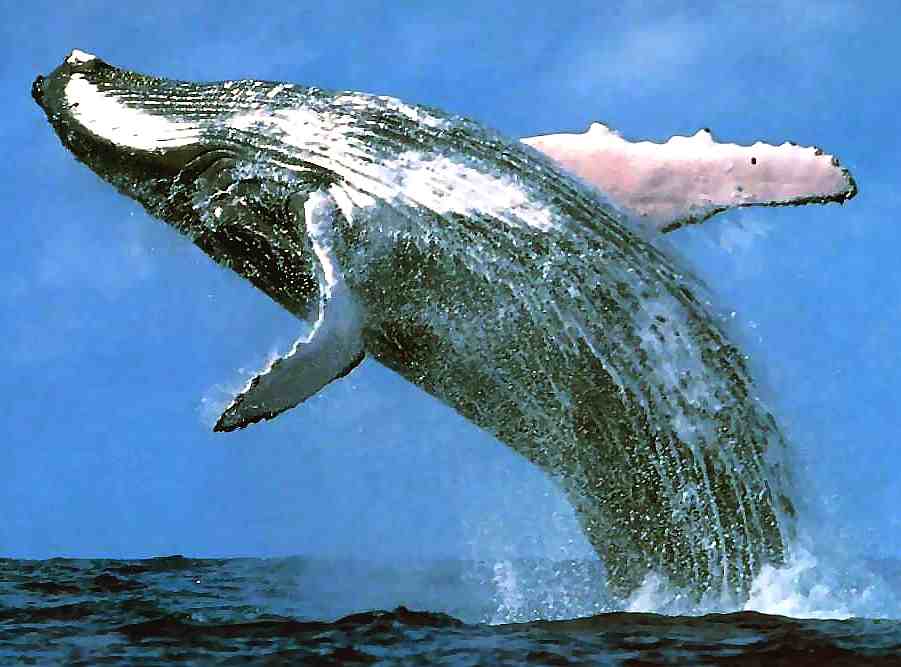
.

Solarnavigator
is a whale friendly trimaran with an extremely efficient
active
hull that runs on clean renewable solar power - a boat in harmony
with nature.
RODENTS:
|
Beaver
Capybara
Chinchilla
Chipmunk
Dormice
Gerbil
Guinea
Pig
Hamster
Mice
Porcupine
Prairie
Dog
Rat
Squirrel
Vole
|
OTHER
ANIMALS:
POPULAR
MAMMALS:
BIRD
INDEX:
|
Albatros
Bishop,
Orange
Blue
Bird
Canary
Chaffinch
Chicken
Cockatoo
Corella, Long-Billed
Cormorant
Crane, African Crowned
Crane
Crow
Cuckoo
Dodo
Dove
Duck
Eagle
Egret, Cattle
Emu
Falcon
Finch
Fishers Lovebird
Flamingo
Grebe
Goose, Egyptian
Grouse
Guinea Fowl, Helmeted
Hammerkop
Hawk
Hornbill, Wreathed
Hornbill, Red-Billed
Hottentot, Teal
House
Martin
Ibis, Hadada
Ibis,
Sacred
Kite, Black
Kingfisher
|
Kiwi
Kookaburra
Lapwing Plover
Lilac-Breasted
Roller
Loon
Macaw
Mynah
Nightjar
Ostrich
Owl
Parrot,
Amazon
Parrot
Partridge
Peacock
Pelican
Penguin
Petrel
Pheasant
Pigeon
Quail
Robin
Roller, Blue-Bellied
Seagull
Sparrow
Spoonbill African
Starling
Stork
Swan
Swift
Toucan
Turkey
Vulture, Griffon
Wader
Weaver, Taveta Golden
Woodcock
Woodpecker
|
POPULAR
INSECTS:
|
Ants
Apid
Army
Ant
Bee
Beetles
Bulldog
Ant
Butterfly
Centipede
Cockroach
Crickets
Damsel
Fly
Death
Watch Beetle
Dragonfly
Dung
Beetle
Earwig
Fly
Grasshopper
Hornet
|
Ladybird
Leafcutter
Ant
Locust
Mantis,
Preying
Maybug
Millipede
Mosquito
Moth
Praying
Mantis
Scarab
Beetle
Stag
Beetle
Stick
Insect
Termite
Wasp
Water
Boatman
Wood
Ant
Woodlice
Woodworm |
|
Blueplanet
Productions 2014 - 2016
|
The
Adventures of John Storm: KULO
LUNA™ - The $Billion Dollar Whale © BUH
Ltd MMXIII |
|
|
Title: |
The
Billion Dollar Whale |
. |
|
Format: |
35mm
Anamorphic 3D* |
to
HD DVD Blu-Ray |
|
Ratio: |
20
to 1* |
. |
|
Runtime: |
110
minutes |
. |
|
Pre-production: |
39
weeks |
. |
|
Shooting: |
11
weeks |
. |
|
Post-production |
15
weeks |
. |
|
A.
Pre-production
unit costs
|
55,370.00 |
L.
Travel
/ hotel accommodation
|
335,000.00 |
|
B.
Above
the line costs -prod execs |
25,907,500.00 |
M.
Publicity
/ screenings |
176,400.00 |
|
C.
Crew
- Main unit |
693,803.00 |
N.
Legal,
accounting. ins (Int, film guarantors) |
477,010.00 |
|
D.
Crew
- 2nd & 3rd units |
278,680.00 |
O.
Contingency
@ 10% |
7,254,830.00 |
|
E.
Cast
+ options |
20,290,000.00 |
P.
Producer's
/ Director's dividends (%) |
TBA |
|
F.
Computer
graphics (CGI) |
17,500,000.00 |
Q.
Distribution
- Direct (costs) |
27,959,000.00 |
|
G.
Art
department |
986,300.00 |
R.
Profit
projected on sales (before corp. tax) |
536,370,000.00 |
|
H.
Equipment |
242,850.00 |
S.
Finance
/ Interest
(5 yrs) |
53,876,570.00 |
|
I.
Location
/ transport / catering |
809,502.00 |
T.
Total
target film cost (production & distribution) |
107,753,138.00 |
|
J.
Stock,
lab, video transfers |
312,195.00 |
U.
Studio
property / equipment (invest) |
TBA |
|
K.
Post
production |
190,510.00 |
. |
. |
|
|
|
. |
. |
|
|
|
Sales |
*698,000,000.00 |
|
|
|
Cost
of Sales |
161,629,710.00 |
|
|
|
Net
Profit* |
*Subj.
corp. taxes |
|
. |
|
. |
|

|
